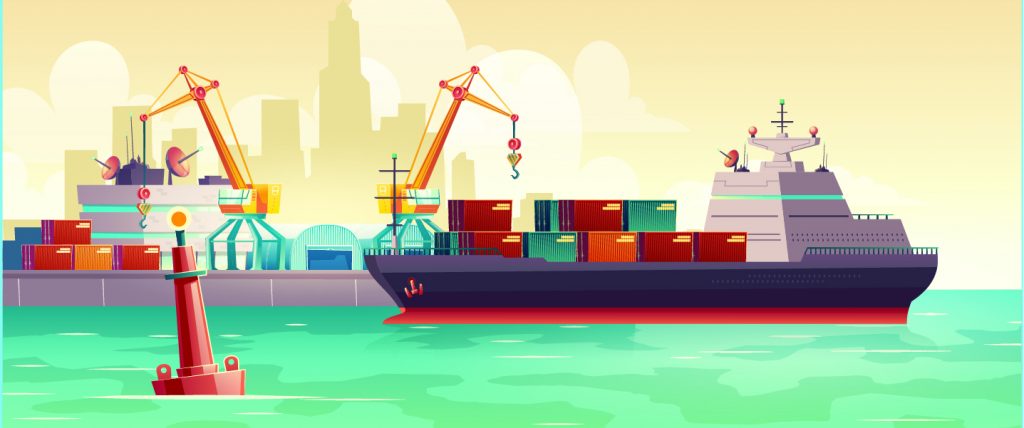Insights
Modernisation of India’s logistics infrastructure and the way forward for the upcoming year
February 6, 2023Logistics Infrastructure – Backbone for development
Logistics is an extremely crucial pillar of India’s economic development. The present logistics infrastructure is insufficient, ill-equipped and ill-designed to support the expected high growth rates of the economy over the next decade or so.

The Logistics Performance Index (LPI), an interactive benchmarking tool created by the World Bank, helps countries identify the challenges and opportunities they face in their performance on trade logistics and what they can do to improve their performance. As per the aggregated LPI for the years 2012-2018, India ranked 42nd out of 167 countries. Despite the relatively low rank, India has a certain advantage because most of its infrastructure network capacity is in the process of being constructed (i.e., it does not have the burden of revamping existing infrastructure). In fact, the logistics sector has witnessed a robust growth in the recent years which has steadied post Covid-19. This growth has been driven by the rising retail and manufacturing ecosystem in the country. Touted as the country’s ‘sunshine industry’, the Indian logistics sector is readying itself to move from its present unorganized, fragmented business model to an organized, regulated structure -and there’s a lot happening to make this possible.
Government’s push to modernise the logistics sector- introduction of the National Logistics Policy
The logistics industry, has praised the launch of the National Logistics Policy (NLP) on September 17, 2022. The much-awaited policy is comprehensive and puts special emphasis on streamlining processes for seamless coordination, and reduction in overall logistics cost, besides incentivising employment generation and skilling of the workforce.
Read More+
The National Logistics Policy lists out the following three key targets:
- Reduce cost of logistics in India to be comparable with global benchmarks by 2030
India’ logistics costs are currently at 13-14 percent of the GDP, which is much higher than the average of 8-10 percent cost incurred by most developed economies. The high indirect costs due to unpredictable supply chains and poor first and last mile connectivity add to the logistics cost. Presently, the sector is also highly fragmented and unorganized.
- Create data driven decision support mechanism for an efficient logistics ecosystem
India has a complex regulatory environment, with multiple and overlapping regulations governed by various stakeholders. For example, there are over 20 government agencies; 37 export promotion councils; 500 certifications; 200 shipping agencies; 36 logistics services; and 129 inland container depots and 168 container freight stations. Additionally, there is also a low level of technology adoption among various stakeholders.
- Improve the Logistics Performance Index ranking, aim to be among top 25 countries by 2030.
The policy has the following key deliverables to be achieved through the Comprehensive Logistics Action Plan (CLAP). They are:
- Integration of digital system (IDS): The IDS will cover 30 different systems belonging to seven departments, integrating data from the road transport, railways, customs, aviation, and commerce departments.
- Unified Logistics Interface Platform (ULIP): This platform will integrate all transportation-related digital services on a single website portal.
- Ease of logistics (e-log): E-log is a digital dashboard under development by the industry department for registering, coordinating, and monitoring time-bound issue resolution. It will include timelines and the status of the resolution. Industry associations can contact the government directly regarding their concerns.
- System Improvement Group (SIG): This group has been created along with the Network Planning Group (NPG) to improve coordination across government ministries and between the state and central governments.
- Facilitating the development of logistics parks: The National Logistics Policy calls for development of logistics parks, including Multi Modal Logistics Parks, Air Freight Stations, Inland Container Depots, Container Freight Stations, Cargo Terminals, etc. For the same, the CLAP framework provides that:
Draft framework guidelines are to be set to facilitate development of logistics parks, with the aid of private investment.
A network of logistics parks is to be created by mapping them on the PM Gati Shakti plan for enhanced visibility, improved logistics efficiency, and connectivity. - EXIM (export-import) logistics: The CLAP framework will identify infrastructure and procedural gaps in India’s EXIM connectivity and create a streamlined and reliable logistics network, with transparent and efficient cross-border trade facilitation. This will not only improve India’s trade competitiveness but also enable greater integration with regional and global value chains.
- Service improvement framework: Improving regulatory interface to enable coordination between different sectors. The framework also aims to eliminate fragmentation in documentation, formats, processes, and liability regimes and reduce gaps in regulatory architecture.
- Standardization of physical assets and benchmarking service quality standards: By standardizing physical assets and setting a benchmark for service quality standards, the government intends to enhance interoperability, minimize handling risks, undertake process optimization, and improve ease of doing business. In warehousing value chains, for example, standardization is essential for reducing costs and ensuring global compatibility and competitiveness
The government of India is investing in the creation of dedicated rail freight corridors that would allow the freight trains to run to exclusive tracks. The dedicated freight corridors will eventually lower the cost of moving cargo by making use of electricity-powered trains with greater capacity. The electricity-powered locomotives will also substantially reduce the environmental impact of the logistics sector. The government of India is taking several important steps to increase the share of rail freight.
To begin with, they have increased the length of the freight trains raised axle loads, and improved the speed of the locomotives. This is helping to enhance the existing rail freight network. Moreover, the massive investment in the creation of the dedicated freight corridor is the most important step towards increasing the efficiency of this sector. Additionally, modal integration across, rail, road, and sea freight and the investments for better train-port-road integration are also important factors that are reinforcing the Indian rail freight industry. Lastly, the robust private sector investments and the government-private partnership for project financing are being seen as significant steps in this regard.
Private sector investment in the logistics sector
Some of the world’s largest logistics players and private equity fund managers are foraying into Indian industrial and logistics spaces in the country which has a total stock of about 350 million square feet. Most players are looking to invest anywhere between $500 million and $1 billion in new ventures in the next couple of years. The highly fragmented nature of the logistics market is another key determinant of private equity interest. Unlike heavily consolidated sectors dominated by a few established players, logistics comprises a dynamic mix of traditional organisations with sprawling operations and disruptive, high-growth up-and-comers looking to transform the industry.
For private equity, fragmentation opens up vast possibilities. It provides a ready supply of right-sized target companies for a classic ‘buy-and-build’ strategy, whereby the PE-backed platform rolls up smaller players. Similarly, the intrinsically global nature of the industry opens up an almost exponentially wider range of acquisition and organic growth opportunities. The digitalisation of the logistics industry creates an additional incentive on both sides of a buyout. On the private equity fund side, their underlying investors are expressing a growing preference for tech-enabled companies and future-proof portfolios. Having previously been viewed as an analogue sector, logistics has quickly become highly innovative.
Changes and shifts required to move forward
As per a report published by McKinsey & Company ‘Transforming the nation’s logistics infrastructure’, there are four main changes that are required to revamp India’s development in the sector:
- Building the right network and ensuring flows on the right mode, comprising an integrated mesh of seven high-density long-distance corridors (rail and coastal waterways).
- Creating enablers to maximise the efficient use of the network, which includes developing 15 to 20 logistics parks, providing standards for containers and pallets and upgrading the skilled workforce.
- Extracting more from existing assets, for example, by increasing the share of toll plazas now with the digitised electronic tolling, using stainless steel wagons with higher load carrying capacity, and increasing spend on maintenance of roads.
- Allocating more investment to rail and reallocating within roads and rail, based on current trends, USD 500 billion is estimated to be spent on logistics infrastructure in the next decade, with roads accounting for more than 50% of the spend and rail for 40%. The allocation to railways, for instance, needs to increase to more than 50% with large sums spent on building high-density traffic corridors, connectors and last mile links.
Conclusion
All in all, the Government’s recent actions and policies promise to boost the sector’s development. The philosophy of integration across movement and storage of goods being proposed by the Government invites optimism from an overall efficiency point of view. Further, by focusing on digital technology, the Government’s aim to upgrade the existing system will compliment such proposed integration and lead to faster, better communication with potentially fewer errors. With this, India hopes to reduce the cost of logistics from 13% and move up to position 25 on the logistics performance index.
This article was originally published in The Times of India on 6 February 2023 Co-written by: Deepto Roy, Partner; Pranav Nanda, Principal Associate. Click here for original article
Read Less-
Contributed by: Deepto Roy, Partner; Pranav Nanda, Principal Associate
Disclaimer
This is intended for general information purposes only. The views and opinions expressed in this article are those of the author/authors and does not necessarily reflect the views of the firm.


